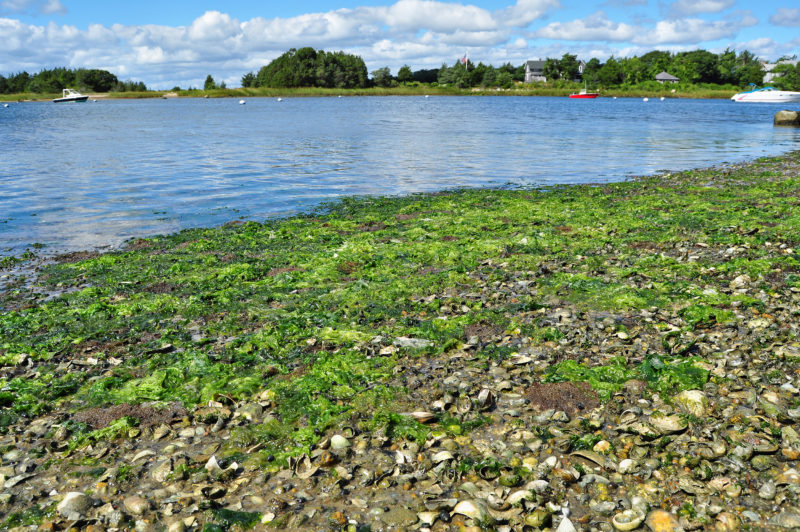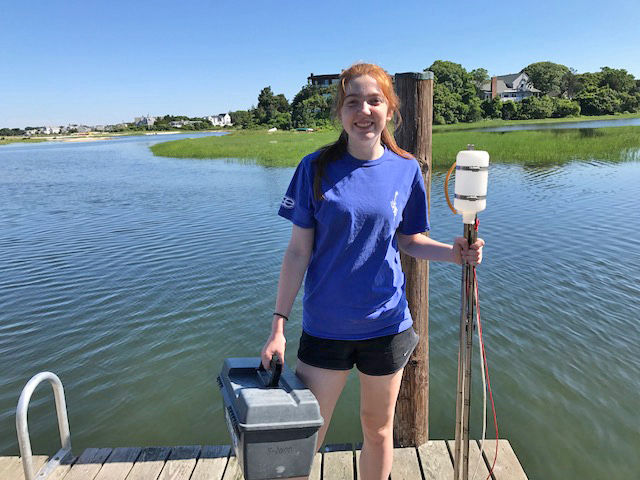Nitrogen pollution cleanup plans released for four Falmouth waterways
The U.S. Environmental Protection Agency has issued long-awaited nitrogen pollution cleanup plans called Total Maximum Daily Loads (TMDLs) for four Buzzards Bay waterways in Falmouth: Quissett Harbor, Wild Harbor, and Rands Harbor/Fiddlers Cove. These cleanup plans set a course for action to restore clean water and healthy marine life in these waterways.

Nitrogen pollution fuels the growth of algae, which can wash up on beaches as slimy green muck.
TMDLs are a critical tool to combat nitrogen pollution, which is the greatest long-term threat to the health of Buzzards Bay. These federally approved pollution limits define exactly how much nitrogen needs to be reduced in a waterway to achieve clean water standards. TMDLs also open the door to new planning and funding opportunities to restore polluted waterways. Put simply, cleanup money flows more quickly to areas with TMDLs.
The Wild Harbor TMDL calls for a 32% reduction of the total nitrogen load. The Rands Harbor/Fiddlers Cove TMDL recommends a 25% reduction in nitrogen, while in Quissett Harbor the TMDL advises a 22% reduction.
At least one-third of the nitrogen reductions to Rands Harbor/Fiddlers Cove need to come from improvements to home septic systems, which are the biggest source of nitrogen pollution to Buzzards Bay. Even properly functioning Title 5 septic systems – which many coastal homes in Falmouth use to treat waste – aren’t designed to remove nitrogen from wastewater.
These TMDLs now provide Falmouth with a guide to reduce pollution to these four Buzzards Bay estuaries. For years, the town has been working to develop and implement nitrogen-reducing projects in Falmouth’s coastal salt ponds along Vineyard Sound, all of which have TMDLs.
West Falmouth Harbor is another waterway that has benefited from receiving a TMDL. In 2012, the Coalition was able to defend the TMDL in a legal action to secure strict pollution limits for Falmouth’s upgraded wastewater treatment facility, which substantially reduced the amount of nitrogen that reaches the harbor. And in 2015, the Coalition partnered with the town to upgrade 20 home septic systems to nitrogen-reducing technology around the harbor. These new systems are being shown to reduce an average of 88% of nitrogen compared to the old systems.

For the past 25 years, the Coalition has been documenting the health of these four Falmouth waterways through water quality data collected as part of our Baywatchers monitoring program.
For the past 25 years, the Coalition has been documenting the health of these waterways through water quality data collected as part of our Baywatchers monitoring program. This data is paired with state-collected data to measure the health of waterways and develop TMDLs.
Unfortunately, Falmouth isn’t the only community that has been waiting for TMDLs to help clean up their local waterways. MassDEP has been sitting on the scientific information needed to create TMDLs for several other Buzzards Bay waterways, including the Slocums/Little River in Dartmouth, Nasketucket Bay in Fairhaven, the Wareham River, and New Bedford Harbor.
Altogether, 27 Buzzards Bay estuaries need TMDLs due to severe nitrogen pollution – but as of today, only six have them. The longer it takes for the state to issue these pollution limits, the worse our waterways get – and the more expensive it’s going to be for our communities to solve the problem.
The Coalition will continue to push for the development of these nitrogen pollution cleanup plans to make sure that every Buzzards Bay waterway has a path to clean water.